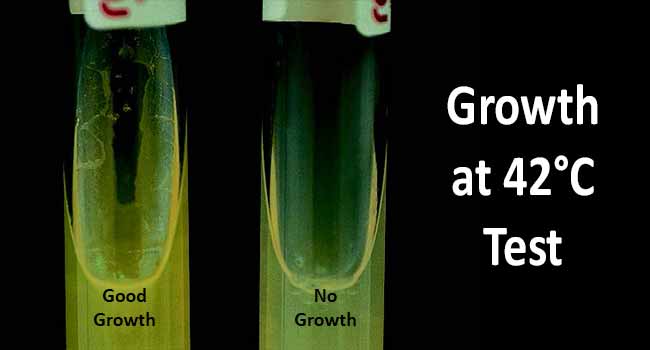Interesting Science Videos
What is Growth at 42°C Test?
The growth at 42°C test is a presumptive identification test used to differentiate between the species of the fluorescent pseudomonas group as well as other non-fermentative bacteria.
- The test is based on the ability of an organism to grow at 42°C, which allows the differentiation of Pseudomonas aeruginosa from the other fluorescent pseudomonads.
- Temperature is one of the important factors that affect the growth rate of different organisms. The temperature at which the growth rate of an organism is the highest is called the optimum growth temperature.
- The minimum temperature at which the growth and survival of an organism occur is the minimum growth temperature.
- Similarly, the highest temperature at which the growth and survival of an organism occur is the maximum growth temperature.
- The ability of an organism to survive and grow at high or low temperature depends on the evolutionary mechanisms that modify the functioning of macromolecules and metabolic activities.
- However, the effect of temperature on different organisms might differ depending on their habitat and genetic composition.
Objectives of Growth at 42°C Test
- To differentiate Pseudomonas aeruginosa from the other fluorescent Pseudomonads.
- To differentiate between other non-fermentative bacteria.
- To detect the ability of an organism to survive at a temperature of 42°C.
Principle of Growth at 42°C Test
Pseudomonas aeruginosa is a Gram-negative aerobic rod that is ubiquitously found in soil, water, and on surfaces that are in contact with water. The optimum temperature for growth of the organism is 37°C, but it is unique in its ability to grow at 42°C. This property differentiates the organism from other Pseudomonas species. The test is thus used for the differentiation of non-pigmented P. aeruginosa and other fluorescent species. For this, an organism is incubated on agar plates and incubated at both 37°C and 42°C. If the organism grows at both 37°C and 42°C, it differentiates it from other organisms that can grow at 37°C but not at 42°C. The test is particularly important for the identification of P. aeruginosa, which is clinically important due to the seriousness of the infections caused by the organism.
Microorganism Tested
- Gram-positive aerobic rods that are resumptive of P. aeruginosa.
- Non-fermentative bacteria
Media, Reagents, and Supplies Used
Media Used
- Tryptic soya Agar is used for the cultivation of fastidious organisms like Salmonella, Pseudomonas, Listeria, etc.
- It is thus used for the testing of the ability of an organism to grow at 42°C.
- The composition of the media is given below:
| S.N | Ingredients | Gram/liter |
| 1. | Tryptone | 17.0 |
| 2. | Soya Peptone | 3.0 |
| 3. | Sodium chloride | 5.0 |
| 4. | Dextrose (Glucose) | 2.50 |
| 5. | Dipotassium hydrogen phosphate | 2.5 |
| 6. | Bacteriological agar | 15.0 |
| Final pH at 25°C: 7.3 ±0.2 | ||
Supplies Used
- Incubator at 37°C and 42°C
- Inoculating loop or needle
Procedure of Growth at 42°C Test
A. Preparation of Media
- In a beaker, 45 grams of the dehydrated powder or lab-prepared media is added to 1000 milliliters of pure, distilled, or deionized water.
- In order to dissolve the media completely, the suspension is heated up to boiling.
- The dissolved medium is then separated into tubes and sterilized in an autoclave at 15 lbs pressure (121°C) for 15 minutes.
- Following the autoclaving process, the tubes are taken out and cooled at a slanted position to a temperature of about 40-45°C. The position should be maintained in order to obtain butts of 1.5 – 2.0 cm depth.
B. Growth at 42°C
- A light inoculum is taken with an inoculating loop by lightly touching the middle of a single 18-24 hour colony.
- The agar slants of both the tubes are then inoculated with the inoculating needle.
- One of the tubes is incubated at 37°C while the other is incubated at 42°C for 24 hours.
- The tubes are then observed for growth.
Result Interpretation

Image Source: Bailey and Scott’s Diagnostic Microbiology. Elsevier.
- Growth at both 37°C and 42°C indicates a positive result.
- Growth at 37°C with no growth at 42°C indicates a negative result.
Control organisms
- Positive: Pseudomonas aeruginosa
- Negative: Pseudomonas fluorescens
Uses of Growth at 42°C Test
- The test is used for the differentiation of apyocyanogenic Pseudomonas aeruginosa from the other fluorescent Pseudomonads.
- Growth at 42°C is also used to differentiate species of the fluorescent Pseudomonas group as well as to differentiate other non-fermentative bacteria.
Limitations of Growth at 42°C Test
- The result of the test might not be consistent as it is dependent on both the method used as well as the strain.
- The result of this test alone shouldn’t be used as a confirmatory test, and other tests like the acetamide utilization tests should be performed for the confirmation of P. aeruginosa.
- The growth at 42°C might differ with the type of growth medium used.
References and Sources
- Oberhofer T. R. (1979). Growth of non fermentative bacteria at 42 degrees C. Journal of clinical microbiology, 10(6), 800–804. https://doi.org/10.1128/JCM.10.6.800-804.1979
- Tryptic Soya Agar. M1968. HiMedia Laboratories.
- Bacteriology Identification. UK Standards for Microbiology Investigations. Standards Unit, Public Health, England. ID 17. Issue no: 3. Issue date: 13.04.15.
- 4% – https://microbenotes.com/citrate-utilization-test-principle-procedure-and-result-interpretation/
- 3% – https://pubmed.ncbi.nlm.nih.gov/118175/
- 2% – https://microbenotes.com/acetate-utilization-test-principle-procedure-and-result-interpretation/
- 1% – https://www.sciencedirect.com/topics/medicine-and-dentistry/pseudomonas-aeruginosa
- 1% – https://www.sciencedirect.com/topics/medicine-and-dentistry/pseudomonas
- 1% – https://quizlet.com/3041225/chapter-42-flash-cards/
- 1% – https://openstax.org/books/microbiology/pages/9-4-temperature-and-microbial-growth
- 1% – https://microbenotes.com/cetrimide-agar-test-principle-procedure-and-result-interpretation/
- 1% – https://jeb.biologists.org/content/214/12/1997
- 1% – https://courses.lumenlearning.com/microbiology/chapter/temperature-and-microbial-growth/
- 1% – http://www.textbookofbacteriology.net/pseudomonas.html
- <1% – https://www.ncbi.nlm.nih.gov/pmc/articles/PMC4157881/
- <1% – https://www.ncbi.nlm.nih.gov/pmc/articles/PMC2928764/
- <1% – http://www.public.asu.edu/~jpbirk/qual/qualanal/confirm.htm
- <1% – http://himedialabs.com/TD/M1968.pdf
